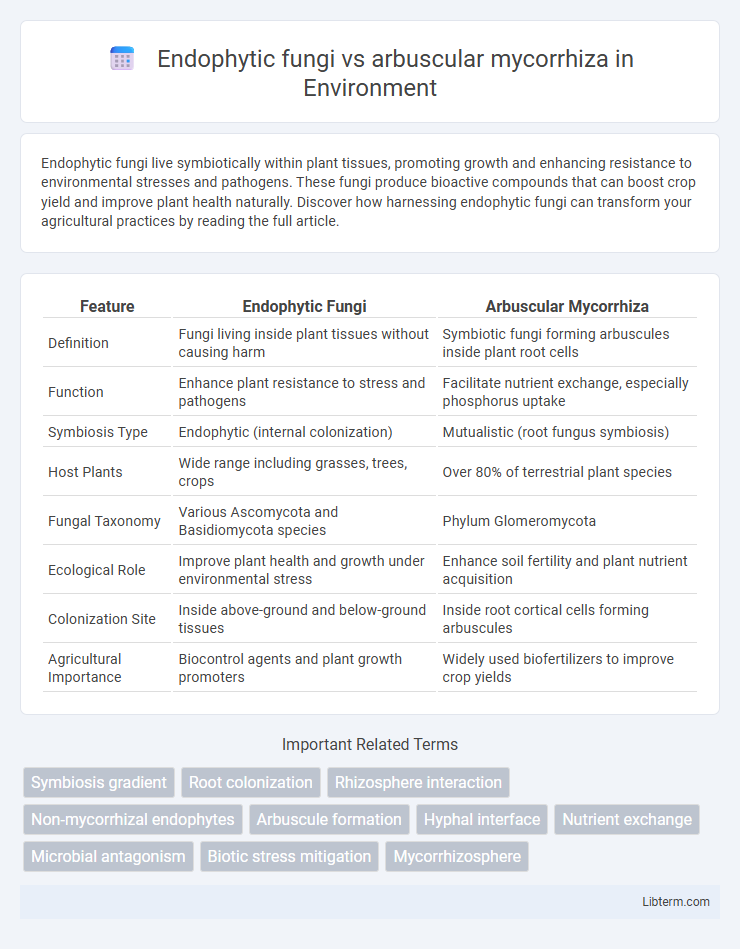Endophytic fungi live symbiotically within plant tissues, promoting growth and enhancing resistance to environmental stresses and pathogens. These fungi produce bioactive compounds that can boost crop yield and improve plant health naturally. Discover how harnessing endophytic fungi can transform your agricultural practices by reading the full article.
Table of Comparison
| Feature | Endophytic Fungi | Arbuscular Mycorrhiza |
|---|---|---|
| Definition | Fungi living inside plant tissues without causing harm | Symbiotic fungi forming arbuscules inside plant root cells |
| Function | Enhance plant resistance to stress and pathogens | Facilitate nutrient exchange, especially phosphorus uptake |
| Symbiosis Type | Endophytic (internal colonization) | Mutualistic (root fungus symbiosis) |
| Host Plants | Wide range including grasses, trees, crops | Over 80% of terrestrial plant species |
| Fungal Taxonomy | Various Ascomycota and Basidiomycota species | Phylum Glomeromycota |
| Ecological Role | Improve plant health and growth under environmental stress | Enhance soil fertility and plant nutrient acquisition |
| Colonization Site | Inside above-ground and below-ground tissues | Inside root cortical cells forming arbuscules |
| Agricultural Importance | Biocontrol agents and plant growth promoters | Widely used biofertilizers to improve crop yields |
Introduction to Endophytic Fungi and Arbuscular Mycorrhiza
Endophytic fungi reside within plant tissues without causing harm, forming symbiotic relationships that enhance host stress tolerance and nutrient acquisition. Arbuscular mycorrhiza fungi penetrate root cortical cells, creating arbuscules that facilitate efficient nutrient exchange, primarily phosphorus uptake, between soil and plant. Both groups play crucial roles in plant health, ecology, and soil nutrient cycling, yet differ structurally and functionally in their symbiotic mechanisms.
Defining Characteristics of Endophytic Fungi
Endophytic fungi colonize the internal tissues of plants without causing apparent harm, forming a symbiotic relationship that often enhances host resistance to stress and pathogens. Unlike arbuscular mycorrhizae, which specifically establish nutrient exchange interfaces in root cortical cells, endophytic fungi inhabit a broader range of plant tissues, including leaves, stems, and roots. These fungi exhibit diverse taxonomic groups and metabolic capabilities, producing bioactive compounds that contribute to plant growth promotion and defense mechanisms.
Overview of Arbuscular Mycorrhizal Fungi
Arbuscular mycorrhizal fungi (AMF) form symbiotic relationships with the roots of over 80% of terrestrial plant species, facilitating nutrient exchange and improving plant phosphorus uptake. Unlike endophytic fungi that inhabit plant tissues without forming specialized structures, AMF penetrate root cortical cells to establish arbuscules, which are sites of nutrient transfer. The widespread presence of AMF enhances soil structure, promotes plant growth, and increases resistance to environmental stressors through a mutualistic interaction.
Modes of Plant Colonization
Endophytic fungi colonize internal plant tissues primarily through intercellular or intracellular penetration without causing harm, establishing a symbiotic relationship that enhances plant growth and stress resistance. Arbuscular mycorrhizal fungi (AMF) form specialized structures called arbuscules within root cortical cells, facilitating nutrient exchange primarily phosphorus uptake between the fungus and host plant. The colonization mode of endophytic fungi involves a more diverse tissue range, while AMF colonization is restricted to root systems with a well-defined intracellular interface.
Mechanisms of Symbiotic Interaction
Endophytic fungi establish symbiotic relationships by colonizing internal plant tissues without causing harm, enhancing nutrient uptake and stress tolerance through the production of bioactive metabolites and modulation of plant hormonal pathways. Arbuscular mycorrhizal fungi penetrate root cortical cells, forming arbuscules that facilitate direct nutrient exchange, primarily phosphorus, in exchange for carbohydrates from the host plant. Both symbioses activate plant immune responses and signaling pathways involving phytohormones such as jasmonic acid and salicylic acid, yet differ in structural integration and molecular dialogue specificity.
Nutrient Exchange and Plant Growth Promotion
Endophytic fungi establish a symbiotic relationship within plant tissues, enhancing nutrient exchange primarily by solubilizing minerals and producing growth-promoting metabolites such as phytohormones. Arbuscular mycorrhiza fungi form specialized structures called arbuscules inside root cells, facilitating efficient phosphorus uptake and improving water absorption, which directly boosts plant biomass and stress resilience. Both fungi types significantly enhance nutrient availability and plant growth, but arbuscular mycorrhizae are particularly crucial for phosphorus cycling, while endophytic fungi contribute broader metabolic benefits.
Stress Tolerance and Disease Resistance
Endophytic fungi enhance plant stress tolerance by producing bioactive compounds and inducing systemic resistance, which help plants withstand drought, salinity, and heavy metal toxicity. Arbuscular mycorrhizal fungi improve nutrient uptake and bolster disease resistance by modulating plant immune responses and enhancing root architecture. Both symbiotic relationships contribute uniquely to plant resilience by activating distinct biochemical pathways and enhancing overall plant health under abiotic and biotic stress conditions.
Ecological Roles in Plant Communities
Endophytic fungi enhance plant resilience by colonizing internal tissues and producing bioactive compounds that deter pathogens and herbivores, thereby promoting plant health and community stability. Arbuscular mycorrhizal fungi form symbiotic associations with plant roots, facilitating nutrient uptake, especially phosphorus, and improving soil structure, which supports plant diversity and ecosystem productivity. Both fungi play complementary ecological roles by enhancing nutrient cycling and stress tolerance, ultimately sustaining plant community dynamics.
Applications in Sustainable Agriculture
Endophytic fungi enhance plant growth and stress tolerance by colonizing internal tissues, promoting nutrient uptake and disease resistance, making them valuable in sustainable agriculture. Arbuscular mycorrhizal fungi establish symbiotic relationships with plant roots, significantly improving phosphorus absorption and soil structure while reducing the need for chemical fertilizers. Both microbial partners contribute to soil health, crop yield improvement, and resilience against environmental stresses, supporting eco-friendly farming practices.
Future Perspectives and Research Directions
Future research on endophytic fungi and arbuscular mycorrhiza emphasizes their combined role in enhancing plant stress tolerance and nutrient uptake amid climate change challenges. Exploring genomic and metabolomic profiles of these symbionts can unlock novel biofertilizers and biocontrol agents. Integrating advanced sequencing technologies and synthetic biology techniques promises to optimize symbiotic efficiency for sustainable agriculture and ecosystem restoration.
Endophytic fungi Infographic

 libterm.com
libterm.com